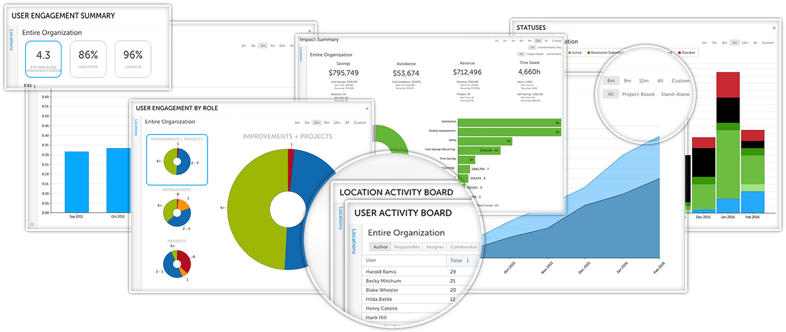 Organizations implement technology to support Kaizen for a number of reasons. It provides structure for improvement, allows for active management of projects, forms a repository of knowledge, gives leaders insight into the health of Kaizen, and allows for tracking of results.
Organizations implement technology to support Kaizen for a number of reasons. It provides structure for improvement, allows for active management of projects, forms a repository of knowledge, gives leaders insight into the health of Kaizen, and allows for tracking of results.
People who try to manage Kaizen work in spreadsheets quickly find that they lack the interactive capabilities necessary to spread and sustain improvement.
Use this free download to compare and rank different Kaizen management systems:
Continuous Improvement Software Comparison Matrix
Download this free matrix to:
- See a list of all features and functionality available in improvement platforms
- Calculate a weighted score for each platform based on available features and your organization's unique needs
- Make an educated, intentional choice about which improvement platform is the best fit for your organization
Technology vendors have taken a variety of approaches to supporting continuous improvement. Some have merely renamed generic project management software and encouraged organizations to use it as such.
We’ve taken a different approach and built our solution from the ground up for the purpose of supporting positive change. That’s given us the ability to weave in some capabilities that we believe are essential to Kaizen management technology.
Whether you consider KaiNexus or not, be sure that any solution you choose has the following attributes.
Bi-Directional Improvement Flow
One of the reasons that Kaizen is such a transformative business methodology is that it marshals every resource in search of opportunities for improvement. This means that sometimes improvement projects are started by leadership, but very often they are started by employees on the front lines. That’s why it is essential to choose a solution that supports improvement workflow whether the idea originates on the factory floor or the boardroom.
Goal Alignment and Strategy Deployment
Many organizations that practice Kaizen also use the Hoshin Kanri or Policy Deployment strategic planning approach. Breakthrough goals are established and cascaded through the organization. Your improvement management software should support this goal alignment effort so that projects can be approved and prioritized in line with the strategic objectives.
Role-Based Configuration
The software should support the needs of each specific user based on their role and function. Leaders should be able to see how improvement is being managed across the organization, while employees may need a more focused view with improvements related to the specific processes they perform.
Data Visualization
If you dig into the techniques used by organizations that practice Kaizen, you will find that many of them involve visual management. Kanban, huddle boards, value stream mapping, and control charts are all examples of visual management techniques. Your Kaizen management system should support visualization in much the same way with digital boards, charts, and dashboards.

Employee Engagement Reporting
To truly enjoy the full benefits of Kaizen, improvement work must be part of every employee’s job description, and it should play an important role in employee performance evaluation. Improvement management software that tracks employee engagement and results makes it easy for supervisors to assess employee activities and provide coaching and encouragement.
Notifications and Alerts
One of the reasons that spreadsheets fail when it comes to Kaizen management is that they are passive. Someone has to remember to go look at it. Quality Kaizen software automates notifying people when a new opportunity is entered, when a task due, or when a due date is missed. This helps ensure forward progress and allows managers to take proactive action when work on a project stalls.
Opportunity Submission via Email
Although you should absolutely choose a cloud-based Kaizen system that is available 24 x 7, sometimes it isn’t practical for someone to login to submit an opportunity for improvement. Look for a system that allows an employee to simply fire off an email to enter a suggestion. That way no opportunism will be missed or forgotten.
Customizable Boards and Workflow
Although many organizations follow a similar approach to Kaizen, your business is unique. The software you choose should have a good foundation, but you should be able to configure it to match your language and processes.
Tracking for Employee Certifications
Whether your use Lean, Six Sigma, or some other business improvement methodology, you likely have some type of employee certification or training program. The best Kaizen management solutions have features that allow for the tracking of these trainings and certifications.
Collaboration Capabilities
The Kaizen mindset rejects the idea of silos and encourages people to work together across functional boundaries. That’s important because opportunities for improvement commonly sit at the junction between processes or departments. Your Kaizen solution should unify the organization on a single platform and streamline collaboration.
Data Security with Encryption and SSL
Any electronic system if vulnerable to intrusion from unauthorized people and systems. That’s why it is essential that your improvement database be protected by encryption and secure application access. We encourage the use of strong passwords and frequent password changes.
Mobile Apps
If the goal is to make participating in Kaizen as hassle-free as possible, be sure to choose a solution that has apps for Android and iOS. That way, employees can participate using the device they already love.
Choosing a Kaizen management system does not need to be difficult. Use these capabilities as a guide and a basis of comparison for each solution you consider, and you’ll end up with a solution that will help your improvement culture thrive.

![[Watch Now] Bottom-Up Improvement](https://no-cache.hubspot.com/cta/default/326641/804fb6fa-7d09-4472-9c33-824363af1f8a.png)

![[WEBINAR] Bottom-Up Improvement Software Demo](https://no-cache.hubspot.com/cta/default/326641/8545f357-84e1-47b2-81e0-f4fa0d3cd893.png)


Add a Comment